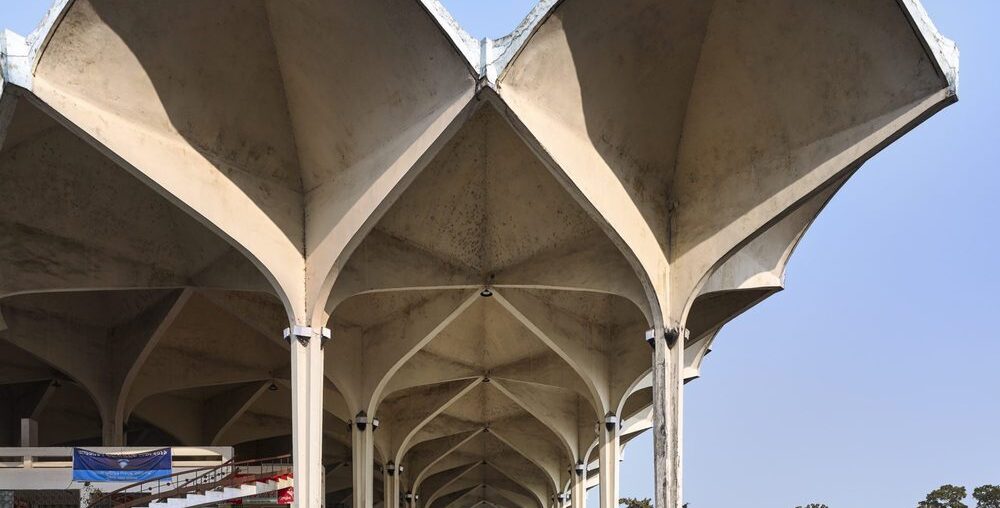
In the mid-twentieth century, a set of South Asian countries collectively experienced a catharsis from colonizers’ rule. The period that followed sparked an era of ideas and philosophies for a new future. During this time, architects were pivotal in creating modernist structures that defined the countries’ post-colonial, post-partition and post-imperial identities. South Asian architects used design as an expression of hopeful societal visions, most of which have been actualized. With this success in nation-building, there has been a lack of accreditation for women architects in shaping South Asian histories.
Pakistan, India, Bangladesh, and Sri Lanka share a major milestone – gaining independence from British Rule. How each country moved forward is unique and contextualized to each region. In relation to architecture, these countries were collectively faced with housing crises, the restoration of heritage buildings, and a need for public institutions. A wave of decolonization washed over South Asia, utilizing modern architecture as a vehicle to liberate from the colonial period.
Looking back in time, one notices a sort of erasure of contribution from women architects to their country’s architectural history. Most of the archives and documentation of modernist South Asian architecture boast of work by male architects such as Geoffery Bawa, B. V. Doshi, and Fazlur Rahman Khan. Hailing from diverse backgrounds, these women architects’ careers were rooted in shaping modernist architecture that represents their countries today:
Pakistan: Yasmeen Lari

Known for her humanitarian approach to design, Pakistan’s first woman architect Yasmeen Lari played a pivotal role in building post-partition Pakistan. Following the population transfers and refugee camps of the 1947 partition of India and Pakistan were severe housing crises amplified by industrialization and urbanization. Yasmeen’s most prominent work explores low-income housing and solutions for social good. Her broad range of designs explores themes of community and belonging, participatory design, local history, and post-colonial culture.
Yasmeen’s design process and activism influence her systemic approach, her work situated at the intersections of architecture, human rights, decolonization, gender, climate change, and vernacular revival. She is well-acclaimed for her zero-carbon constructions using traditional materials and techniques native to Pakistan. The architect’s practice also extends to historical documentation and preservation, aiming to conserve and reinterpret the traditional architecture of her country.

Bangladesh: Marina Tabassum

Marina Tabassum’s contextualized work in her native country Bangladesh inspires architects across the world. Rooted in responsibility towards local communities, Marina’s buildings utilize local materials to improve the lives of low-income communities in the country. Her work also focuses on building in tune with the natural environment, tackling environmental challenges that threaten the country’s resources.
Post-partition Bangladesh suffered the pressure of millions of refugees and industrial decline. The country continues to have high income inequality and an urgent need for affordable housing. There is a current trend of urban migration is driven by rural poverty, river erosion, and natural calamities. Growing up amongst these conditions has influenced the Dhaka-based architect’s designs. Viewing architecture as a social responsibility, she understands the need to be deeply indulged in a cultural context to design for impact.

India: Pravina Mehta
The freedom movement against the colonial settlement in India marks a major turning point for socio-political-economical change in India. With this shift came a desire for expressing an independent India’s resurgent identity through modern architecture. One architect who was equally involved in the freedom struggle was Pravina Mehta, pausing her architectural education to join mass movements against British Rule. Pravina’s interests ranged from art and politics to design and city planning.
Pravina was well aware of the disparities between social classes in India, especially in the provision of housing. As a socially committed urban planner, she was motivated to promote egalitarian values and social justice in housing facilities for India’s extremely diverse population. She paid close attention to social and psychological issues that arose in communities and used her insights to design for varied lifestyles. Through her designs, Pravina aims to express the rich Indian heritage in contemporary architecture, drawing inspiration from traditional art forms.

Sri Lanka: Minnette de Silva

During the mid-twentieth century, like most South Asian countries, Sri Lanka underwent a rebirth after gaining independence from British rule. Significant political change and a vision of an idealized nation-state prompted a shift from colonialism to decolonization. What resulted is a return and reproduction of traditional identity, made evident in the architecture and built environment.
At this crucial phase in the country’s history, architect Minnette de Silva’s work exemplified cultural and local specificity in tandem with the global modern movement. The Sri Lankan architect’s practice indulged an amalgamation of raw materials, local techniques, and artisanal traditions to create modernist buildings. Her work aimed to ensure a means of living for impoverished craftspeople. Minnette pioneered Critical Regionalism in her home country, recognizing the impact of climate, community, and crafts in contemporary Sri Lankan architecture.

This article is part of the ArchDaily Topics: Women in Architecture presented by Sky-Frame.
Sky-Frame is characterized by its empathic ability to take on different perspectives and points of view. We are interested in people and their visions, whether in architecture or in a social context. We deeply care about creating living spaces and in doing so we also question the role of women in architecture. From the arts to the sciences, women shape our society. We want to shed more light on this role, increase the visibility of Women in Architecture and empower/encourage them to realize their full potential.
Initiated by Sky-Frame, the “Women in Architecture” documentary is an impulse for inspiration, discussion, and reflection. The film’s release is on November 12, 2024.
Every month we explore a topic in-depth through articles, interviews, news, and architecture projects. We invite you to learn more about our ArchDaily Topics. And, as always, at ArchDaily we welcome the contributions of our readers; if you want to submit an article or project, contact us.
__________
Originally published on October 24, 2022.





